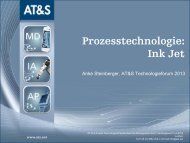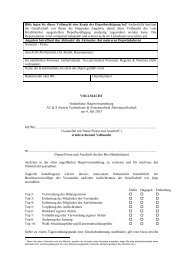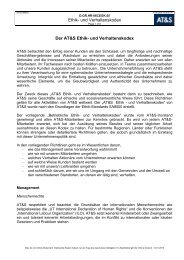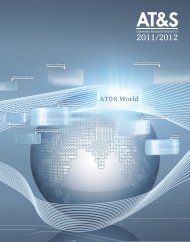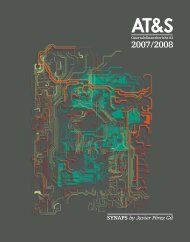AT&S World
AT&S World
AT&S World
You also want an ePaper? Increase the reach of your titles
YUMPU automatically turns print PDFs into web optimized ePapers that Google loves.
Consolidated Financial Statements as of 31 March 2011<br />
64<br />
h. Impairment losses and reversals of impairment losses of<br />
property, plant and equipment, intangible assets and noncurrent<br />
assets held for sale<br />
The Group regularly reviews the carrying amounts of its property,<br />
plant and equipment and intangible assets for possible<br />
impairment. If the recoverable amount of an asset is below its<br />
carrying amount, an impairment loss amounting to the difference<br />
is recognised. The recoverable amount is the higher of an<br />
asset’s fair value less costs to sell and value in use. The value<br />
in use corresponds to the estimated future cash flows expected<br />
from the continued use of the asset and its disposal at the end<br />
of its useful life.<br />
Goodwill is tested annually for impairment. If events during the<br />
financial year or changes in circumstances indicate that goodwill<br />
might be impaired, an impairment test will be carried out<br />
immediately. Goodwill is allocated to cash-generating units for<br />
the purpose of impairment testing.<br />
Non-current assets are classified as held for sale and measured<br />
at the lower of their carrying amounts or fair values less costs<br />
to sell, if their carrying amount will be recovered by sale rather<br />
than by continuing use in the business.<br />
If the reason for the impairment recognised in the past no longer<br />
exists, with the exception of goodwill, a reversal of impairment<br />
up to amortised cost is made.<br />
i. Inventories<br />
Inventories are stated at the lower of cost or net realisable value.<br />
Net realisable value is the estimated selling price in the ordinary<br />
course of business, less variable costs necessary to make the<br />
sale. Cost is determined by the first-in, first-out (FIFO) method.<br />
The cost of finished goods and work in progress comprises raw<br />
materials, direct labour, other direct costs and related production<br />
overheads, but excludes interest expense.<br />
j. Trade and other receivables<br />
Receivables are reported at nominal values, less any allowances<br />
for doubtful accounts. Foreign currency receivables are<br />
translated at the exchange rate prevailing at the balance sheet<br />
date. Risk management provides for all recognisable credit and<br />
country-specific risks.<br />
k. Financial assets<br />
The purchase or sale of financial assets shall be recognised and<br />
derecognised, as applicable, using trade date accounting or settlement<br />
date accounting. The fair values recognised in the balance<br />
sheet generally correspond to market prices of financial<br />
assets. Except for financial assets “at fair value through profit<br />
or loss” they are recognised initially including transaction costs.<br />
Financial assets are divided into categories explained below. The<br />
classification depends on the respective purpose of the financial<br />
asset and is reviewed annually.<br />
Financial assets at fair value through profit or loss<br />
Financial instruments acquired primarily for the purpose of<br />
earning a profit from short-term fluctuations of prices or trader<br />
margins are classified as financial assets at fair value through<br />
profit or loss. At the time of their acquisition they are stated<br />
at cost, excluding transaction costs, in subsequent periods at<br />
their respective fair values. Realised and unrealised profits and<br />
losses are credited or charged to the income statement under<br />
“Financial result”. This relates primarily to securities held for<br />
trading. Derivative financial instruments also fall into this category,<br />
unless hedge accounting is applied (refer to l. Derivative<br />
financial instruments).<br />
Securities held to maturity<br />
Securities held to maturity are recognised at amortised cost using<br />
the effective interest rate method. Any impairment is recognised<br />
in profit or loss.<br />
Loans and receivables<br />
Loans and receivables are non-derivative financial assets with<br />
fixed or determinable payments which are not quoted in an active<br />
market. In the balance sheet the respective assets are recognised<br />
under the item “trade and other receivables”.<br />
Financial assets available for sale<br />
Financial assets available for sale, on the one hand, relate to<br />
securities available for sale. Securities available for sale are instruments<br />
which management intends to sell as a reaction to or<br />
due to expected liquidity requirements or expected changes in<br />
interest rates, exchange rates or share prices. Their classification<br />
as non-current or current assets depends on the expected<br />
time to be held.



